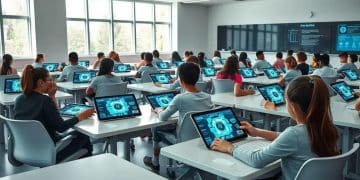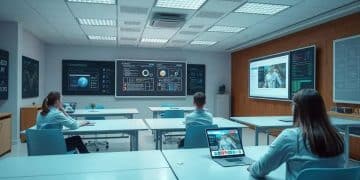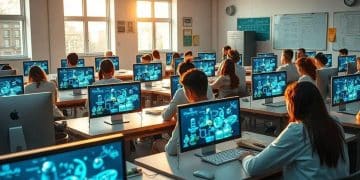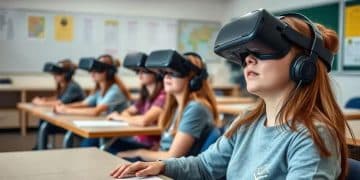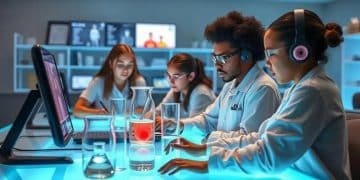School technology integration trends: what to expect
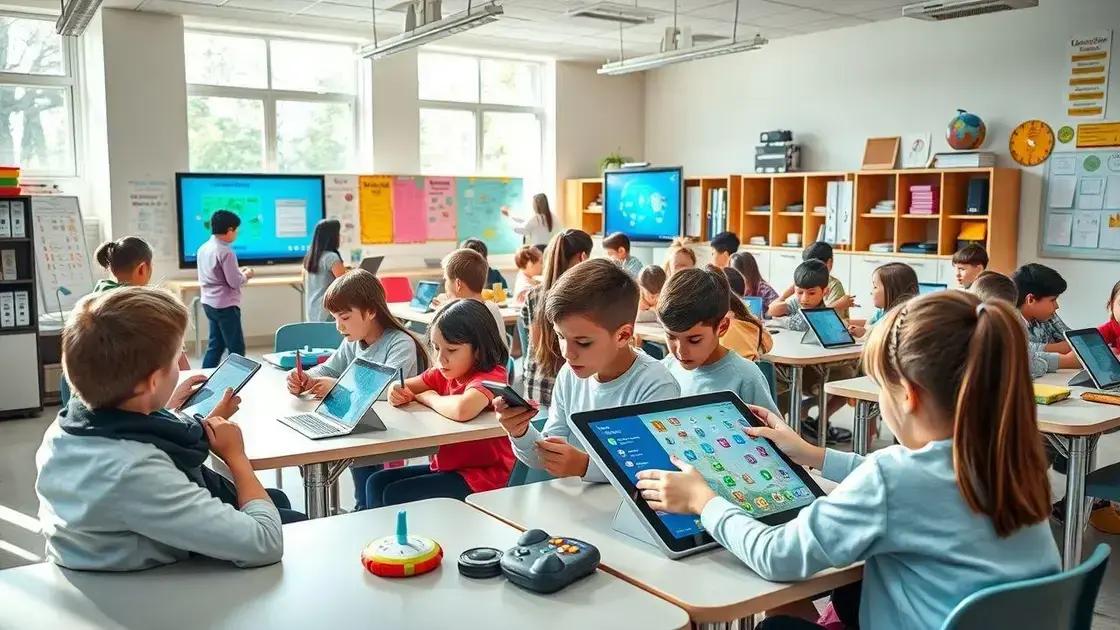
School technology integration trends involve using tools like AI and VR to create personalized, engaging learning experiences, while addressing challenges such as cost and cybersecurity risks.
School technology integration trends are changing how students learn and teachers instruct. Have you wondered how these innovations can shape the classroom experience? In this article, we’ll delve into the latest trends forming a tech-savvy educational landscape.
Current technologies shaping classrooms
Currently, several exciting technologies are reshaping classrooms to provide better learning experiences. Interactive whiteboards, virtual reality (VR)learning management systems (LMS) are just a few examples of how innovation is driving education forward.
Interactive Whiteboards
These boards have replaced traditional chalkboards. They allow teachers to display multimedia content, engage students with interactive lessons, and save notes for future reference. Students can also interact directly with the content on the board, making lessons more engaging.
Virtual Reality
With virtual reality, students can experience immersive learning. Imagine traveling back in time to see history unfold or exploring the depths of the ocean from your classroom! This technology enhances understanding through real-life experiences that textbooks cannot provide.
- Enhances engagement through immersive experiences
- Helps in visualizing complex concepts
- Encourages collaboration in group tasks
Moreover, learning management systems have transformed how educators administer courses and track progress. These systems allow teachers to upload materials, track assignments, and communicate with students in one place. It simplifies the learning process and provides students with easy access to their resources.
Adaptive Learning Technologies
An additional innovation is adaptive learning technologies, which personalize the learning experience. They assess each student’s performance, identify strengths and weaknesses, and adjust coursework accordingly. This ensures that all students learn at their individual pace, leading to better results.
As classrooms adopt more advanced technologies, students are better prepared for the future. Skills like collaboration, critical thinking, and problem-solving are enhanced through these tools. Staying informed about current technologies can help educators utilize them effectively, fostering an environment where students thrive.
Key benefits of tech integration in education
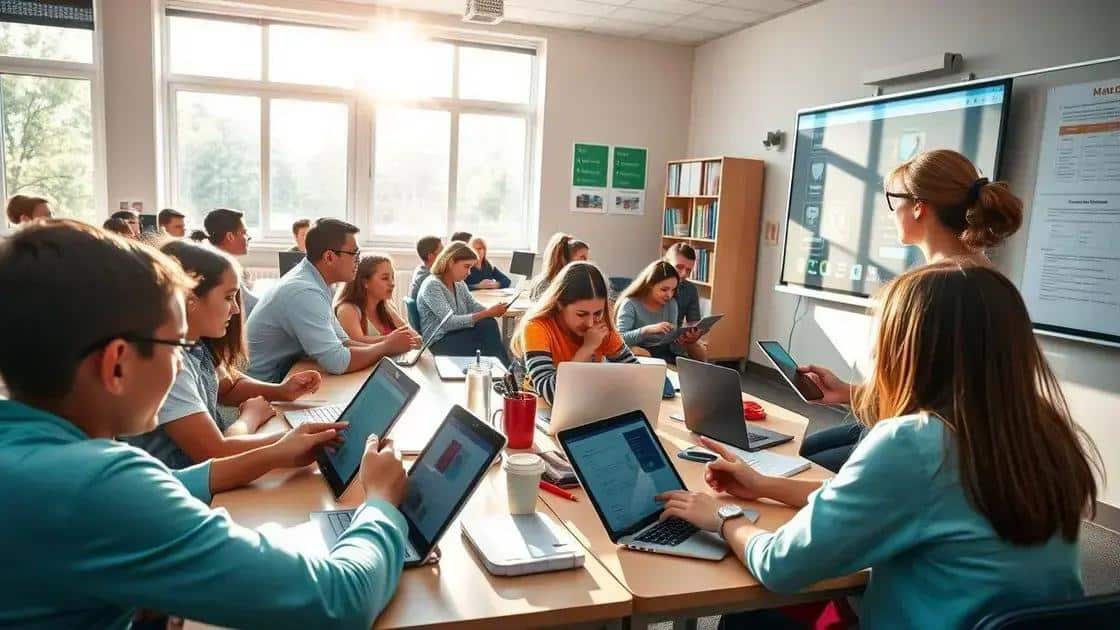
The integration of technology in education brings numerous benefits that can enhance both teaching and learning experiences. One of the most significant advantages is the way it fosters greater student engagement. With tools like interactive software and educational games, lessons become more captivating and enjoyable.
Personalized Learning
Another key benefit is personalized learning. Technology allows educators to tailor lessons to meet individual student needs. They can use data analytics to monitor progress and adjust instruction accordingly. This approach ensures that every student can learn at their own pace.
- Identifies students’ strengths and weaknesses
- Creates customized lesson plans
- Enables targeted interventions
Moreover, technology facilitates collaboration among students. Tools such as collaborative documents and video conferencing applications encourage teamwork and communication. Working together on projects via technology helps students develop critical social skills that are essential in today’s world.
Access to Resources
The digital age provides unprecedented access to a wealth of information. With just a few clicks, students can discover articles, videos, and other materials related to their studies. This instant access to resources enriches their learning experience and broadens their knowledge base.
Teachers also benefit from technology integration. They can utilize online resources for lesson planning, find new teaching methods, and share best practices with one another. This not only enhances their effectiveness but also promotes ongoing professional development.
In essence, tech integration creates a more dynamic and effective educational environment. By leveraging technology, both students and teachers can engage more deeply in the learning process, making education more impactful.
Challenges in implementing school technologies
Integrating technology in schools is beneficial, but it also comes with its own set of challenges. One major issue is the lack of training for teachers. Many educators are not adequately trained to use new technologies in their classrooms. This can lead to frustration and ineffective use of resources.
Cost of Implementation
Another significant challenge is the cost of implementation. Schools must often invest in new hardware, software, and infrastructure, which can strain limited budgets. Additionally, ongoing maintenance and updates are necessary, adding to the overall expense.
- High initial costs for purchasing devices
- Recurring costs for software licenses
- Need for technical support and upkeep
Furthermore, there is often resistance to change among both staff and students. Some educators may prefer traditional teaching methods. Students can also be reluctant to embrace new technologies. This resistance can slow down the integration process.
Equity and Access
Equity is another critical concern. Not all students have equal access to the necessary technology at home. This gap can widen the digital divide, where some students thrive in tech-rich environments while others struggle. Schools must find ways to ensure that all students can benefit from technological advancements.
Finally, there are issues related to cybersecurity. As schools adopt more technology, the risk of data breaches and cyberattacks increases. Protecting student information and maintaining a secure digital environment are vital to successful technology integration.
Future predictions for tech in schools
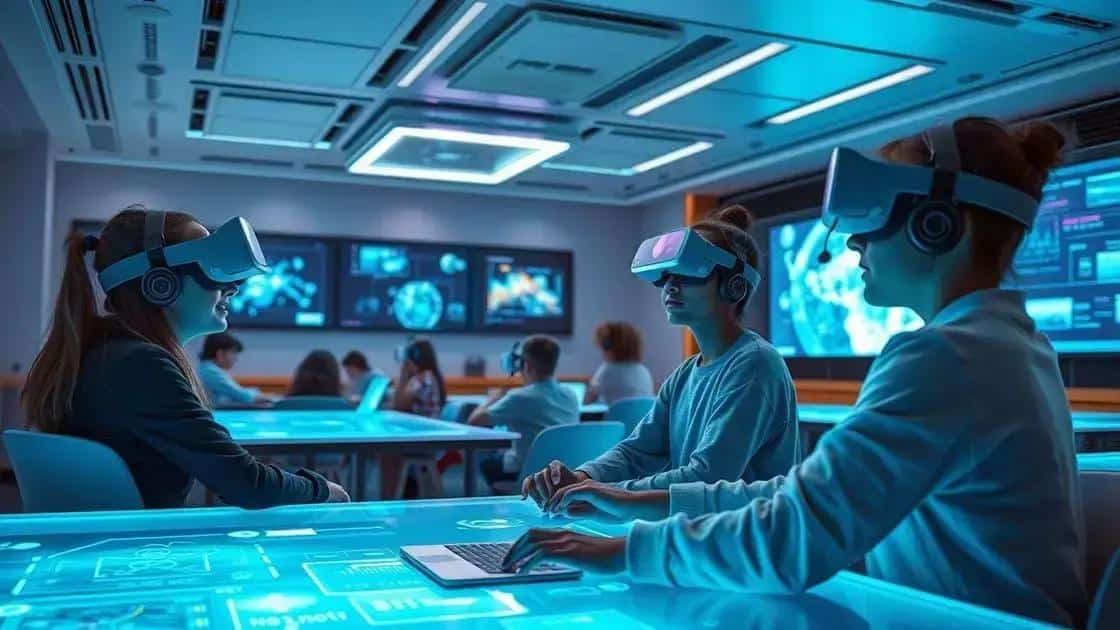
The future of technology in schools looks promising, with several exciting trends on the horizon. As we move forward, artificial intelligence (AI) is expected to play a vital role in education. It can help create personalized learning experiences tailored to individual student needs, allowing for a more effective learning process.
Increased Use of Virtual Reality
Virtual reality (VR) will also become more common in classrooms. Students will have the ability to explore historical sites or dive deep into the ocean without leaving their seats. This immersive experience can make learning more engaging and memorable.
- Field trips to historical places through VR
- Simulations of scientific experiments
- Interactive language learning environments
Furthermore, the use of cloud technology will revolutionize how students access information. With cloud storage, students can collaborate on projects in real-time, share resources, and work together, regardless of their physical location. This connectivity can enhance teamwork and improve communication skills.
Emphasis on Data Analytics
Another trend is the emphasis on data analytics. Teachers will have access to more data on student performance, helping them make informed decisions about instruction. This data-driven approach promises a more tailored and efficient learning experience.
Moreover, the push for improved cybersecurity measures will ensure that student information remains safe as technology becomes further integrated into schools. Schools will prioritize protecting sensitive data while still providing innovative solutions.
As we look ahead, it’s clear that these advancements will not only change how students learn but also how teachers instruct. Embracing these technologies will help prepare students for a rapidly evolving world.
In conclusion, the integration of technology in education is transforming how students learn and teachers teach. Artificial intelligence, virtual reality, and data analytics are just a few examples of how advancements are enhancing educational experiences. While challenges exist, such as resistance to change and cybersecurity concerns, the benefits far outweigh the drawbacks. As we look toward the future, embracing these technologies will help prepare students for the demands of the modern world and foster a more engaging learning environment.
FAQ – Frequently Asked Questions about Technology Integration in Schools
What is the role of artificial intelligence in education?
Artificial intelligence helps create personalized learning experiences tailored to each student’s needs, enhancing their overall learning process.
How can virtual reality be used in classrooms?
Virtual reality allows students to experience immersive learning environments, such as virtual field trips or simulations of real-world scenarios, making lessons more engaging.
What are the challenges of implementing technology in schools?
Challenges include the cost of technology, lack of training for teachers, resistance to change, and concerns about cybersecurity.
How will data analytics improve education?
Data analytics enables educators to track student performance and make informed decisions, leading to more effective teaching strategies and improved learning outcomes.

